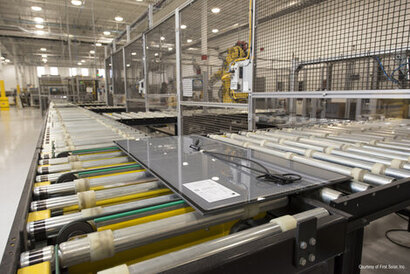Fraunhofer ISE researchers have demonstrated for the first time the feasibility of the shingling approach with perovskite-silicon tandem solar cells. They also produced full format photovoltaic modules with a power conversion effciency of 22.8%.
A group of scientists led by Germany’s Fraunhofer Institute for Solar Energy Systems (Fraunhofer ISE) have sought to apply for the first time the shingling interconnection technology to perovskite-silicon tandem (PVST) solar cells.
“The combination of PVST cells with shingling allows boosting the module efficiency even further due to the increase of the photoactive area through the absence of cell gaps,” the research’s lead author, Veronika Nikitina, told pv magazine. “Technologically, shingling suits the temperature limitations of the PVST cells since the main factor for the choice of the processing temperature is the curing conditions of the electrically conductive adhesive.”
Shingled panels feature a busbar-free structure in which only a small proportion of cells are not exposed to sunlight. The cells are bonded with electrically conductive adhesive to form a shingled high-density string and the resulting strips are connected. The reduced number of busbars reduces shadowing losses.
“A significant advantage of combining PVST cells and shingling is the relaxed requirements on finger resistivity due to the relatively low cell current density,” the scientists said. “Additionally, shingling does not utilize ribbons and requires only one cell side to be printed with electrically conductive adhesives (ECAs).”
They also stressed that shingling utilizes less material while lowering thermomechanical stress in the panels. It also increases a cell’s active area, thus raising the device’s fill factor and power conversion efficiency. Furthermore, shingled solar modules have an improved shading resilience compared to non-shingled products.
The researchers used M6 (166 mm x 166 mm) precursors with a two-terminal (2T) configuration provided by solar perovskite specialist Oxford PV. Metallization with low-temperature silver paste by means of screen printing deploying 60 fingers and continuous busbar took place at Fraunhofer ISE whereas cutting the cells into 1/5 shingles with 24.5% efficiency was realized at Oxford PV’s plant in Brandenburg, Germany. Shingles were shipped back to Fraunhofer ISE in Freiburg for interconnection and module integration.
“The optimum number of fingers on the front side was determined by sweeping number of fingers while keeping the number of fingers at the rear side as well as finger dimensions and busbar dimensions constant,” they also explained, noting that they utilized cell-to-module (CTM) analysis to assess the impact of the number of fingers and shingle size on the module efficiency.
Through their analysis, the academics found that the 1/6 cut PVST cells with 25 % initial shingle cell efficiency would be able to achieve a module efficiency of 23.4 %.
“The feasibility of the shingling approach as well as module integration with PVST cells was demonstrated by producing full-format modules,” the group said, adding that it produced real bifacial glass-glass solar panels based on industrial production equipment, which reached efficiencies of up to 22.8 %. “Metallization of PVST precursors with low-temperature silver paste by means of screen-printing with subsequent cutting with laser scribe and mechanical cleave method was successful.”
The novel cell design was introduced in the study “Shingling meets perovskite-silicon heterojunction tandem solar cells,” published in Solar Energy Materials and Solar Cells.






